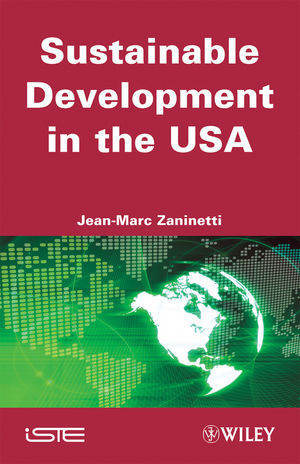Sustainable Development in the USAISBN: 978-1-84821-133-9
Hardcover
320 pages
September 2009, Wiley-ISTE
 |
||||||
Introduction ix
Chapter 1. The American Territory 1
1.1. A continent-nation with a dispersed population 1
1.2. Major geographical areas 5
1.3. Unfavorable climatic factors 9
1.4. Physical geography of the US 17
Chapter 2. Developing the Territory 23
2.1. Agricultural regions 23
2.2. An agriculture which does not influence settlement 29
2.3. The abundance and limits of natural resources 33
2.4. Working towards the sustainable management of the American forest 33
2.5. Fossil resources-abundance and dependence 36
2.6. The case of fossil fuels 37
2.7. Environmental protection 46
Chapter 3. A Rapidly Growing Population 49
3.1. A relatively high fertility rate due to immigration 50
3.2. Life expectancy and aging 51
3.3. Aging – regional disparities 53
3.4. Immigration to the United States of America. 54
3.5. The country’s gateways 58
Chapter 4. A Multi-ethnic Nation 63
4.1. Native peoples 64
4.2. A nation of immigrants 66
4.3. The African-American question 68
4.4. America and Mexico 76
4.5. Geography of the population of Asian origin 82
Chapter 5. Regional Dynamics 85
5.1. Main features of settlement in the US territory 89
5.2. The dynamics of regional settlement between 1930 and 2005 95
Chapter 6. Economic Change and Territories 99
6.1. A changing economy 99
6.2. Economic growth 102
6.3. Industrial change105
6.4. A population on the move 108
6.5. Migration of retired populations 117
Chapter 7. A Suburban Nation 119
7.1. Urban sprawl 121
7.2. Big cities 126
7.3. Consequences of urban sprawl on sustainable development 131
7.4. Urban sprawl is not only a big city phenomenon 133
Chapter 8. Urban Fragmentation and Sprawl 137
8.1. Social divisions find expression in land use patterns 137
8.2. The challenge of governance in fragmented metropolitan areas 171
8.3. The crisis of cities 174
Chapter 9. New Orleans in Dangerous Waters 177
9.1. The physical components of natural hazards 178
9.2. Increased vulnerability from urban sprawl 184
9.3. The consequences of a natural disaster 195
Conclusion 203
Glossary 211
References 239
List of Tables and Figures 245
Index 251



